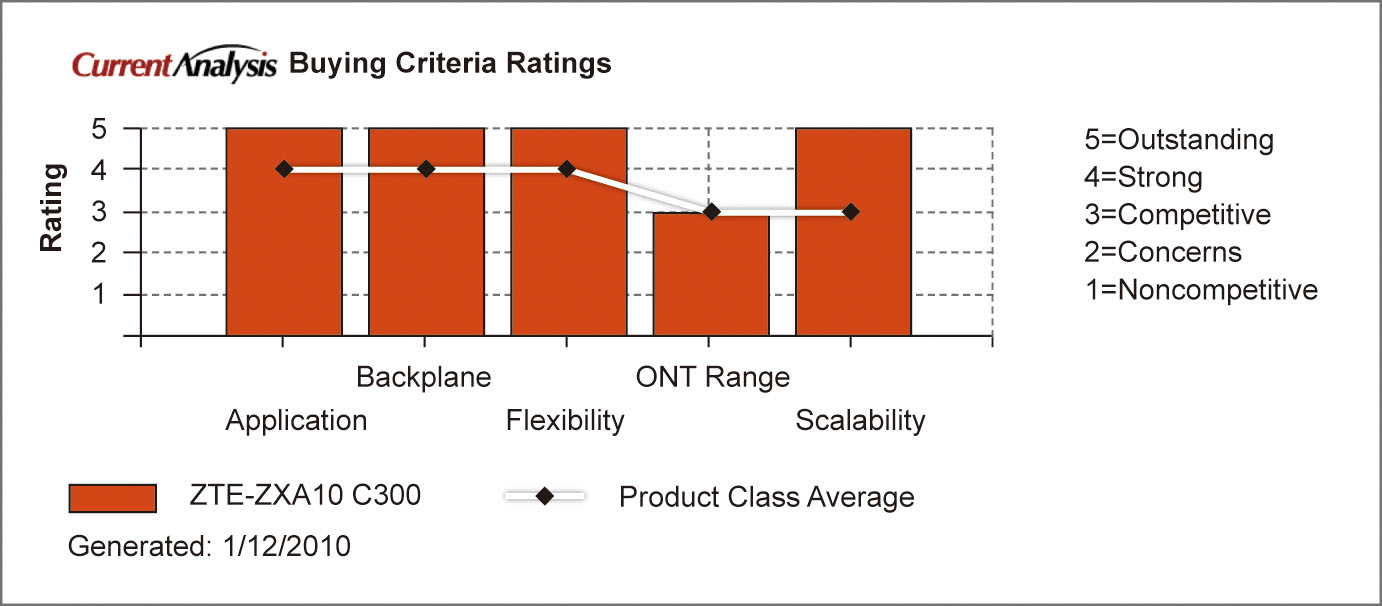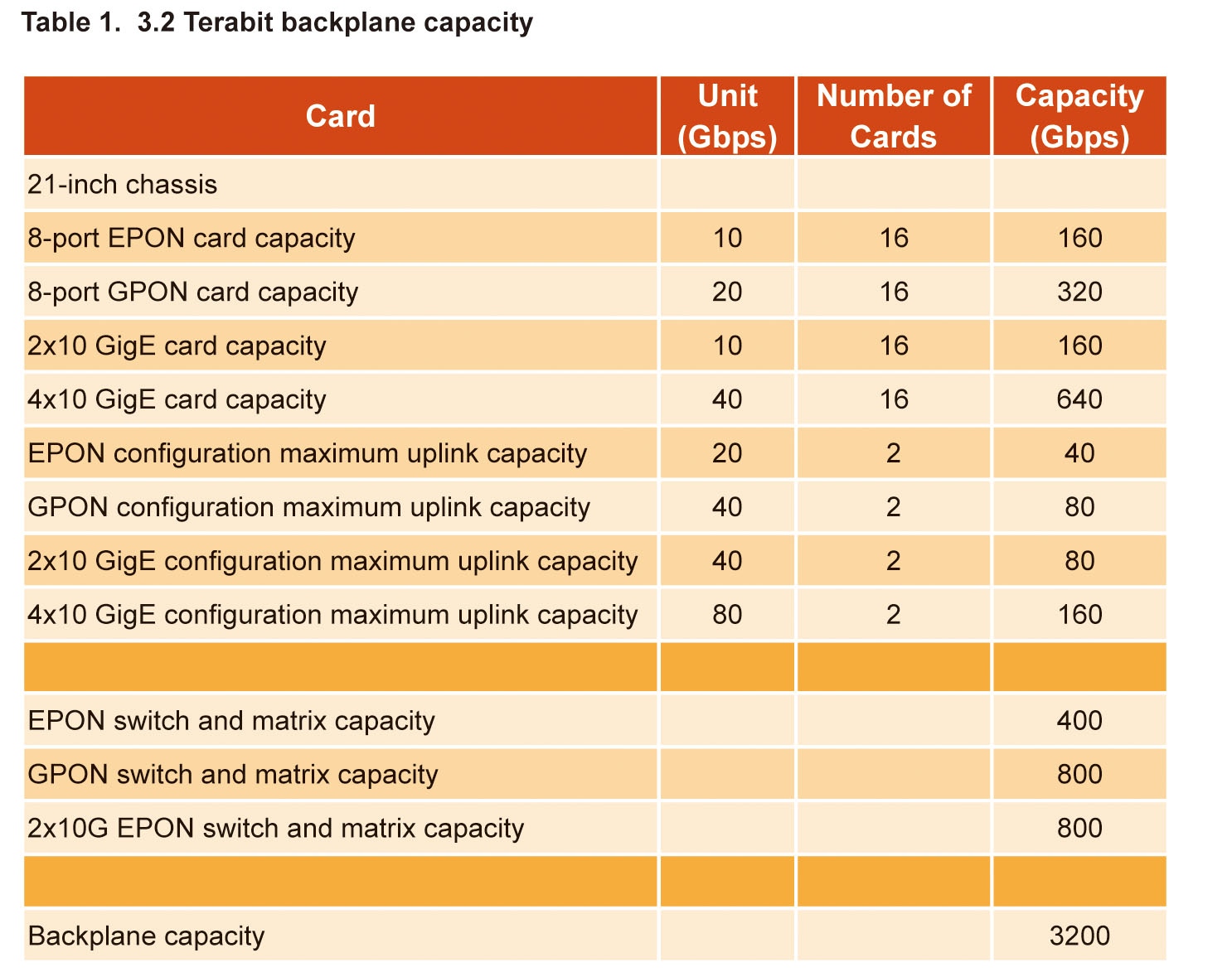ZTE's ZXA10 C300
Current Perspective
ZTE’s ZXA10 C300 solution is very threatening to competitors in the global FTTP market. The new ZXA10 C300 platform is one of only a handful of FTTP OLT solutions that supports both standards-based GPON and EPON, not to mention point-to-point active Ethernet (AE) FTTP and 10G EPON. This gives ZTE a solid competitive advantage in terms of deployment flexibility vis-à-vis rival vendor OLTs, most of which will support only one or two of the various FTTP connectivity options.
ZTE asserts that its xPON solutions (specifically EPON and GPON) have been widely deployed in operators networks worldwide since 2004. These deployments include FTTH, FTTC, FTTO, FTTB, FTTB+LAN, and FTTB+DSL configurations; customers include China Telecom, China Netcom, China Mobile, Shanghai Broadband, Telecom Malaysia, PCCW, Telecom Italia, and other operators.
In terms of key metrics, ZTE’s ZXA10 in the C300 configuration supports 400/800Gbps and 20/40Gbps of bandwidth per subscriber slot. 400Gbps of redundant throughput places the C300 at the sharp end of the FTTP OLT spectrum, with only a small group of vendors able to assert backplane/switching capacities that are equal or higher; likewise, 20Gbps of per-slot throughput is the current high-tide mark for OLTs.
ZTE’s ZXA10 C300 platform, which first debuted in Q4 2008 at an Italian telecom trade show, has been generally available since June 2009. However, for such a powerful platform (again from the speeds/feeds standpoint), ZTE has engaged in a rather limited marketing campaign, which can even be construed as a “soft” launch, compared to other vendors offering similar solutions. Whether this is a function of ZTE’s still-low-profile marketing strategy or due to limited availability of the C300 (or both) remains an open question.
Buying/Selecting Criteria

Application support/system robustness
■ Since the majority of ZTE’s xPON customers, which include Tier 1 operators such as China Telecom, China Netcom, and China Mobile, have deployed the ZXA10 in multiple FTTx variations, there is limited insight into how robust the system is in support of full fiber (FTTP) configurations. Again, based on the datasheet specs, the ZXA10 C300 appears to have the switch matrix and throughput capabilities to deliver mass-market, high-end services, but without specific customer proof points of these speeds/feeds, it is difficult to ascertain the full range of capabilities of the ZXA10 in production networks.
■ ZTE cites the following support capabilities for multicast/IPTV on the new C300 platform: 2K multicast groups via IGMP v1/2/3 (i.e., snooping and proxy); multicast VLAN (MVLAN); channel access control (CAC); preview (PRV) and call detail record (CDR) for IPTV; and less than 50ms channel zapping delay.
■ ZTE also highlights the following QoS capabilities: eight queues per port, queue scheduling (SP, WRR, or SP+WRR); IPv4 DSCP Diffserv; stream classification, rate limiting, shaping and priority setting; traffic statistics; WRED; and triple color support.
Backplane/system throughput capacity
■ ZTE’s ZXA10 platform features a fully redundant 400Gbps backplane, which supports 20Gbps per slot (double these numbers in non-redundant math). This places ZTE at the front of the FTTP OLT pack of contenders, tied with Zhone’s new MXK platform on both counts, but behind Alcatel-Lucent’s market-leading 500Gbps of backplane capacity.
■ ZTE’s total throughput claims for the new C300 chassis―i.e., 2.8 to 3.2 Terabit backplane capacity (for the 48.3-cm/19-inch wide, 21-slot and 528-cm/21-inch wide, 23-slot versions, respectively)―are exceptional; in fact, only Huawei and ZTE have engaged in this particular marketing tactic, which is to tout the aggregate capacity of a all-line card in a fully-loaded chassis (see Table 1).

Density/scalability
■ The ZXA10 C300 supports four and eight-port GPON subscriber cards, which when deployed in the 14 or 16-subscriber port chassis, supports 56/112 and 64/128 GPON ports per OLT. With a 1:32 split ratio (the benchmark for this product comparison), this supports 1,792/3,584 and 2,048/4,096 ONTs per chassis. The maximum split ratio for GPON deployments is 1:128, on par with rival GPON OLTs.
■ The ZXA10 C300 supports four and eight-port EPON subscriber cards, which when deployed in the 14-port or 6-subscriber-port chassis, supports 56/112 and 64/128 EPON ports per OLT; with a 1:32 split ratio (the benchmark for this FTTP product class comparison), this supports 1,792/3,584 and 2,048/4,096 ONTs per chassis. Since the IEEE standard restricts EPON split ratios to 1:32, these are maximums.
■ The ZXA10 C300 supports 16, 32, and 64-subscriber port point-to-point (P2P) active Ethernet line cards, which deployed in the 14-port or 16-port chassis, scales to 224/448/896 and 256/512/1,024 active Ethernet subscribers per chassis.
■ The ZXA10 C300 also supports two and four-port 10G EPON; when deployed in the 14-port or 16-port chassis, which with a 1:32 split ratio (assuming the current IEEE standard), this equals 896/1,792 and 2,048/4,096 ONUs/ONTs/subscribers per chassis.
■ In terms of WAN uplinks, the ZXA10 C300 supports the following cards: 4×10GigE, 4/8/16×GigE, 1×STM-4/OC-12, 2×STM-1/OC-3, and 32×E1/T1 (balanced and unbalanced).
Deployment flexibility
■ The ZXA10 C300 is one of a small handful of FTTP OLT platforms supporting both GPON and EPON; the fact that it also supports active Ethernet and 10G EPON gives ZTE additional differentiation, at least from a data sheet perspective. For reference, Enablence’s TRIDENT7 was one of the first OLTs to supports both GPON and EPON, and ZTE still needs a commercial, operator deployment of the 10G EPON solution for customer/market validation.
■ In addition to the EPON/GPON/AE/1 0G EPON capabilities of the ZXA10 solution set, the fact that ZTE’s customers have deployed the platform in a broad array of FTTx configurations—FTTH, FTTC, FTTO, FTTB, FTTB+LAN, and FTTB+DSL—highlights the deployment flexibility of the ZXA10 series.
■ The ZXA10 solution set also supports long-reach PON (i.e., up to 60-km/37-mile links from the OLT to the ONU/ONT), giving operators the ability to deliver FTTP services within a much larger serving area than the standard 20km link. However, ZTE is certainly not unique in this respect, and there is a bandwidth tradeoff with long-reach PON (e.g., a 20Mbps connection at 20km will likely be 10Mbps at 40km).
ONT range
■ ZTE asserts support for a full range of ONT form factors for both indoor and outdoor deployments, but other than offering FTTB+Ethernet and FTTB+DSL systems with optical WAN interfaces, it is not highly differentiated from rival vendors in this respect.